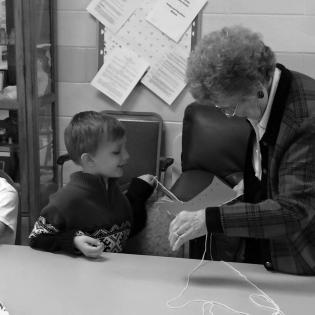Autobiography and Interviews
Young people prepare for their visit to the retirement home by writing an autobiography. They work together to come up with questions to ask their senior friends.
The learners will:
- write an autobiography as an introduction for their senior friend.
- prepare to interview their senior friend for the Living History book.
- handouts below
- Folders or clipboards and pencils for taking notes during the interview
- Shoebox (one for every two children) and decorating materials
- read-aloud book by Patricia Polacco with an interesting family story
*To reduce the number of visits, the facilitator can drop off the remembering boxes so the first visit can also be the interview visit.
Notes from the author of the lesson: The excitement and response after this first visit and interview is enough to keep me doing this project each year. I continue to be amazed at the sensitivity and rapport the children and seniors have for each other immediately. Try to write down quotes as you hear them, like “My girl had red hair just like I do.” or “Our senior friend still has his memory…it’s a good one…he told us so much!” or “We got candy from our lady!” or “I don’t want to leave yet; it wasn’t’ long enough. or “When are we going back?” or “We got all of the questions answered!”
Prior to this lesson, children complete the Living History Autobiography Checklist (handout) as homework. Set the due date for their rough draft so they are ready to work on the autobiographies the day you begin this lesson.
Instructions
Anticipatory Set:
Read aloud a book by author Patricia Polacco to illustrate how stories from families are interesting and may bring out information about history and personal integrity and generosity. Discuss the relationship between this story and the Living History project.
Show the “about the author” paragraph in the book. Discuss what information authors share about themselves. Call attention to any personal facts that relate to the content of the story the author wrote. Tell the children that they are going to write their own “about the author” piece based on the facts they brought from home on the handout.
Split up the group so half are at the computers, and the rest are decorating “remembering boxes.” They switch places halfway through the time together.
At the computer, children write autobiographies based on their notes taken from home. They should print their rough drafts for peer or home editing. The autobiographies may be edited and finalized before the first or second visit to the retirement home.
Pairs of children decorate and label a “remembering box” similar to the one in the story Wilfrid Gordon McDonald Partridge by Mem Fox. They will be giving this box with the note Living History Remembering Box Letter (handout belowt) to the senior prior to their interview visit. The senior friend adds items to the box to get to know one another. It may be something special such as photos of themselves, drawings, or friendly notes.
Work as a whole group to draft ideas for interview questions for their visit to the retirement home. They may get ideas from the Interview Notes handout and fun time comparison guide (below).
First Visit to the Retirement Home:
Before leaving for the first visit, review the sensitivity training and proper procedures to be used at the retirement facility. At the retirement home, they may get a tour and an introduction from a staff member with guidelines for the visit.
When they are paired up with a resident, the children introduce themselves to their senior friend, give their remembering box with instructions, and ask the senior friend how they wish to be addressed. This may be a time for a brief conversation and a snack. If time allows, the children may start their interview and/or share their autobiographies.
Second and Third Field Trips to Retirement Home
Arrange one to three more visits to finish their interviews and develop relationships over conversation, snacks, games, and stories.
Philanthropy Framework
-
Strand PHIL.I Definitions of Philanthropy
-
Standard DP 06. Role of Family in Philanthropy
-
Benchmark E.2 Identify examples of families supporting giving and sharing.
-
-
-
Strand PHIL.II Philanthropy and Civil Society
-
Standard PCS 01. Self, citizenship, and society
-
Benchmark E.3 Describe a benefit of group cooperation.
-
Benchmark E.5 Identify one local citizen who has helped the community through giving and/or service.
-
-
Standard PCS 02. Diverse Cultures
-
Benchmark E.2 Discuss the importance of respect for others.
-
Benchmark E.4 Demonstrate listening skills.
-
-
Standard PCS 03. Philanthropy and Economics
-
Benchmark E.13 Describe limited resources and scarcity.
-
Benchmark E.3 Give examples of <i>opportunity cost</i> in philanthropic giving.
-
-
-
Strand PHIL.III Philanthropy and the Individual
-
Standard PI 01. Reasons for Individual Philanthropy
-
Benchmark E.1 Describe one reason why a person might give or volunteer.
-
Benchmark E.7 Give classroom examples of when a student does not need the teacher's permission to act philanthropically.
-
-
-
Strand PHIL.IV Volunteering and Service
-
Standard VS 03. Providing Service
-
Benchmark E.1 Provide a needed service.
-
Benchmark E.3 Describe the task and the student role.
-
Benchmark E.4 Demonstrate the skills needed for the successful performance of the volunteer job.
-
Benchmark E.5 Articulate and demonstrate the safety procedures that are part of the volunteer experience.
-
Benchmark E.6 Describe the procedures and the importance of sensitivity to the people with whom students are working.
-
-
